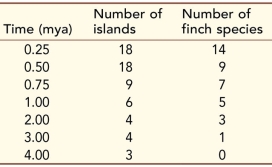The different finch species in the phylogeny shown in the 22.8 of the textbook have all evolved on islands of the Galápagos archipelago within the past 3 million years.Molecular clock analysis (see Chapter 23) has been used to determine the dates of the various speciation events in the phylogeny.Geological techniques for dating rock samples (see Chapter 24) have been used to determine the ages of the various Galápagos islands.The table shows the number of species of Darwin's finches and the number of islands that have existed in the archipelago at several times during the past 4 million years.  Plot the number of species of Darwin's finches and the number of islands in the Galápagos archipelago (dependent variables) against time (independent variable).
Plot the number of species of Darwin's finches and the number of islands in the Galápagos archipelago (dependent variables) against time (independent variable).
Are the data consistent with the hypothesis that isolation of populations on newly formed islands is related to speciation in this group of birds? Why or why not?
Correct Answer:
Verified
View Answer
Unlock this answer now
Get Access to more Verified Answers free of charge
Q116: In terms of their reproductive capacity, mules,
Q117: Speciation rates in plants are _ in
Q118: A tetraploid fish is generated by autopolyploidy.Its
Q119: One major category of reproductive isolating barriers,
Q120: Except in cases of polyploidy, sympatric speciation
Q122: You begin a study of colorful spiders
Q123: The morphological species concept, used by Linnaeus
Q124: The morphological species concept is defined by
Q125: Refer to the table. Q126: Refer to the figure ![]()
![]()
Unlock this Answer For Free Now!
View this answer and more for free by performing one of the following actions

Scan the QR code to install the App and get 2 free unlocks

Unlock quizzes for free by uploading documents